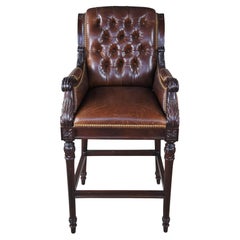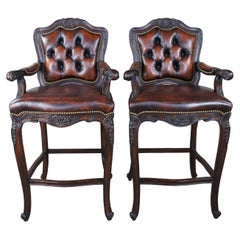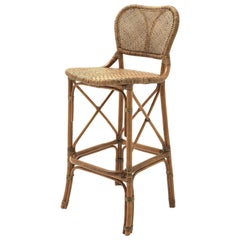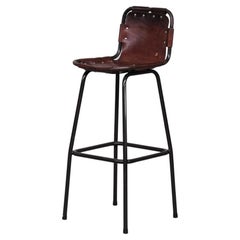Hancock & Moore Stools
2
to
2
2
2
2
1
2
2
Height
to
Width
to
Depth
to
1
1
2
2
2
1
1
4
297
271
148
132
Creator: Hancock & Moore
Hancock & Moore French Chesterfield Style Carved Brown Leather Tufted Bar Stool
By Hancock & Moore
Located in Dayton, OH
Exquisite Hancock & Moore French Chesterfield Bar Stool. Features an acanthus carved mahogany frame with scrolled tufted back, upholstered in a rich top grain brown leather with nai...
Category
Late 20th Century Chesterfield Hancock & Moore Stools
Materials
Leather, Mahogany
2 Hancock & Moore French Louis XV Style Carved Brown Leather Tufted Bar Stools
By Hancock & Moore
Located in Dayton, OH
Pair of Hancock & Moore French Country / Louis XV style bar stools. Features a carved and scalloped frame with brown leather seats and tufted back. Accented by brass nail head trim...
Category
Late 20th Century Louis XV Hancock & Moore Stools
Materials
Leather, Hardwood
Related Items
Rattan Style Bar Stool
Located in Paris, FR
Bar stool rattan style all in
natural rattan in clear finish.
Category
21st Century and Contemporary Indonesian Hancock & Moore Stools
Materials
Rattan
French Mid-Century Leather Bar Stools, '1'
Located in London, GB
A good run of bar stools.
France, c1960s.
In the manner of the Perriand dining chairs.
Leather and iron.
The leather is has patina consistent with age but is not torn...
Category
Mid-20th Century French Hancock & Moore Stools
Materials
Leather
A Louis XV style painted and carved upholstered foot stool C 1920.
Located in Philadelphia, PA
A Louis XV style painted and carved upholstered foot stool C 1920.
Category
1920s Louis XV Vintage Hancock & Moore Stools
Materials
Upholstery, Wood
Hancock & Moore Oxblood Burgundy Leather Chesterfield Tufted Office Chairs Pair
Located in Philadelphia, PA
Vintage Hancock & Moore Oxblood Burgundy Leather Chesterfield Button Tufted Office Lounge Chairs - a Pair. Item features brass nailhead trim, solid mahogany wood frame, original labe...
Category
1980s Chesterfield Vintage Hancock & Moore Stools
Materials
Leather
H 42 in W 26 in D 30 in
19th Century French Louis XV Style Hand Carved Gilt Wood Foot Stool Tapestry
Located in Sofia, BG
Beautifully executed with fine attention to details, French Louis XV style carved gilt wood stool on cabriole legs ending with snail feet, deco...
Category
Mid-19th Century Louis XV Antique Hancock & Moore Stools
Materials
Giltwood, Tapestry
No Reserve
H 7.09 in W 25.6 in D 9.06 in
Guerin Leather Accent Armchair by Hancock & Moore
By Hancock & Moore
Located in Lake Worth, FL
Offering One Of Our Recent Palm Beach Estate Fine Furniture Acquisitions Of A
Genuine Leather Accent Office Guerin Armchair by HANCOCK & MOORE
This listing and price are for th...
Category
1980s Mid-Century Modern Vintage Hancock & Moore Stools
Materials
Mahogany, Leather
Early 20th Century French Louis XV Carved Oak Stool with Black Leather
Located in Dallas, TX
This elegant, antique Louis XV stool was crafted in France, circa 1920. The large rectangular footstool sits on four cabriole legs decorated with scrolled motifs at the shoulders ove...
Category
Early 20th Century French Louis XV Hancock & Moore Stools
Materials
Walnut, Leather
Isotta Leather Bar Stool
By Enrico Pellizzoni
Located in Milan, IT
A fresh and stylish design of minimalist inspiration, this gorgeous bar stool boasts clean and essential lines highlighted with a total-white look. Boasting a sleek structure defined...
Category
2010s Italian Modern Hancock & Moore Stools
Materials
Leather
Louis XV-Style Giltwood X-Shaped Folding Stool / Curule Seat
Located in Dallas, TX
a Louis XV-style carved and gilded X-shaped folding stool / curule seat with a plump red and gold Damask printed velvet cushion / pillow with elaborate passementarie embellishments i...
Category
20th Century French Louis XV Hancock & Moore Stools
Materials
Velvet, Wood, Giltwood, Trimming
Hancock & Moore Signed Burgundy Oxblood Tufted Chesterfield Loveseat Sofa
By Hancock & Moore
Located in West Hartford, CT
Rare to see an oxblood/burgundy colored signed Hancock & Moore sofa/loveseat in this scale - measuring 68" wide so perfect your not only a larger space, but also a NYC apartment. El...
Category
Late 20th Century American Hancock & Moore Stools
Materials
Brass
Late 20th-C. Chesterfield Style Leather Chairs Att. to Hancock and Moore, Pair
By Hancock & Moore
Located in Kennesaw, GA
These chairs are have timeless appeal. This is a pair of saddle leather Chesterfield style chairs. They are attributed to Hancock and Moore bu...
Category
Late 20th Century American Chesterfield Hancock & Moore Stools
Materials
Leather, Fruitwood
H 39 in W 28 in D 26.5 in
19th Century French Louis XV Carved Walnut Stool with Green Velvet
Located in Dallas, TX
Crafted in southern France circa 1890 and round in shape, the traditional stool stands on cabriole legs decorated with floral motifs at the shoulders...
Category
Late 19th Century French Louis XV Antique Hancock & Moore Stools
Materials
Velvet, Walnut
Hancock & Moore stools for sale on 1stDibs.
Hancock & Moore stools are available for sale on 1stDibs.
Questions About Hancock & Moore Stools
- What are Sicilian Moor heads?1 Answer1stDibs ExpertApril 5, 2022Sicilian Moor heads, also known as “teste di moro,” are ceramic vases that originated in Sicily. Moor heads come in pairs — one is the head of a man and the other is the head of a woman. On 1stDibs, you’ll find a collection of antique and contemporary Sicilian Moor heads from some of the world’s top sellers.
- 1stDibs ExpertApril 5, 2022Henry Moore’s sculptures often represented the connection between the human body and landscapes. The underlying meaning is that humanity is shared with the natural world, and many of his large-scale sculptures were created to compliment the outdoor landscape where they were placed. You’ll find a selection of Henry Moore sculptures and sketches on 1stDibs.
- Why did Henry Moore draw hands?1 Answer1stDibs ExpertMay 30, 2024Henry Moore drew hands to symbolize the passage of time. His series of drawings depicting his own hands in old age and other elderly people's hands were meant to represent the effects of work and living on the human body. Much of Moore's work reflected on the human form, including his large bronze sculptures. Explore a diverse assortment of Henry Moore art on 1stDibs.
- 1stDibs ExpertApril 5, 2022Henry Moore frequently used the wax resist process in his drawings, which involved sketching the forms in wax crayon and coating the drawing with a wash of gray watercolor. He then went in with black ink, gray and black crayons and white watercolor. Find a selection of Henry Moore artwork from top art dealers around the world on 1stDibs.
- 1stDibs ExpertMay 3, 2024Opinions vary as to what Henry Moore's most famous piece is. Since the British artist's semi-abstract monumental bronze sculptures are often public works of art, many have become well known. Among them are Reclining Figure: Festival (1951), Harlow Family Group (1954-5), Helmet Head No. 4: Interior/Exterior (1963), The Arch (1963-69) and Mother and Child (1983). On 1stDibs, find a variety of Henry Moore art.
- Why did Henry Moore draw sheep?1 Answer1stDibs ExpertMarch 13, 2024Henry Moore drew sheep for a few reasons. The British artist thought sheep were peaceful and found watching them graze to be relaxing. He also liked how they stood out against the landscape due to their coloring, likening it to the way a statue draws the eye away from the rest of its surroundings. On 1stDibs, find a diverse assortment of Henry Moore art.
- 1stDibs ExpertApril 26, 2024Henry Moore created sculptures for a few reasons. Born in Castleford, Yorkshire, in 1898, he had an early interest in being a sculptor, and in 1921, he was awarded a scholarship to study at the Royal Academy of Art in London. As he would explain, this is where he was particularly inspired to pursue his sculpting practice: “Even when I was a student I was totally preoccupied by sculpture in its full spatial richness, and if I spent a lot of time at the British Museum in those days, it was because so much of the primitive sculpture there was distinguished by complete cylindrical realization.” He also had an interest in exploring how the human body connected to landscapes. He often produced works with specific locations in mind, considering how his figures would relate to the space around them. His forms are usually abstractions of the human body, typically depicting mother-and-child or reclining figures, and are often pierced or contain hollow spaces. Many interpreters liken the undulating form of his reclining figures to the landscape and hills of his Yorkshire birthplace. On 1stDibs, shop a variety of Henry Moore art.
- 1stDibs ExpertApril 5, 2022Henry Moore moved to London to study art and often visited the British Museum where he was inspired by ancient sculptures from Egypt, Africa and Mexico. His sculptures have a semi-abstract nature, but he often dabbled in other styles of art. Moore even created his own form of modernism with an eye toward the abstract. On 1stDibs, find a variety of original artwork from top artists.
- 1stDibs ExpertApril 5, 2022Henry Moore used holes in his sculptures to create the illusion that his work was growing from an empty center. His sculptures Oval with Points and Double Oval are two examples of the technique. You'll find a selection of Henry Moore art on 1stDibs.
- 1stDibs ExpertApril 5, 2022Henry Moore was a prolific artist and it’s difficult to pinpoint exactly how many pieces of art he created. The Henry Moore Foundation lists that their online catalogue of his works currently features more than 11,000 sculptures, drawings, tapestries, textiles and graphics. That’s a significant number indeed and does not represent all of his contributions to the art world. On 1stDibs, find a variety of original artwork from top artists.



